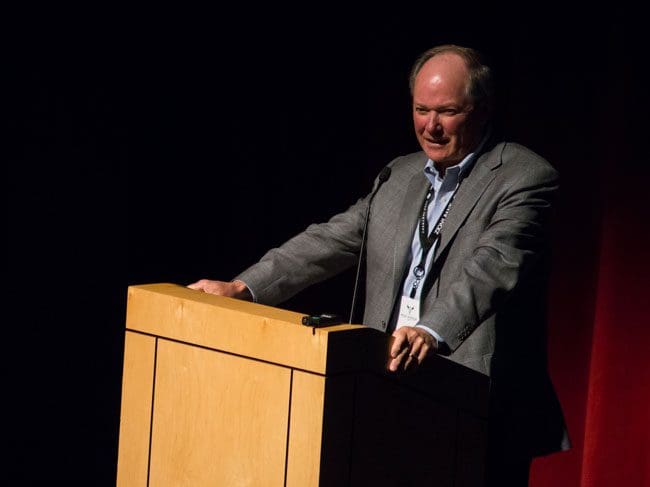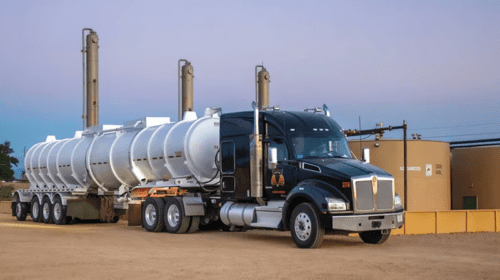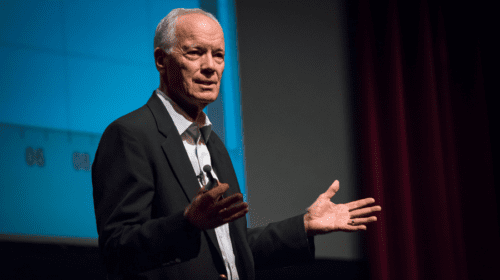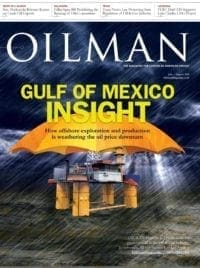Jason Spiess: Looking back at 2014, with all the activity in the Bakken with their wet gas, the infrastructure in Louisiana and other shale plays, was 2014 the “Year of Natural Gas” for the country?
Ron Jibson: I think it is very applicable (to the northwest area of the U.S.). It started prior to 2014, but obviously the shale plays have been a paradigm shift in our industry. We always knew there was gas in the shale, but we could not economically get that gas out. Now with the technology of horizontal drilling and the continued ability to use fracking – fracking is not new, we’ve been doing it for 25 years – but with the technologies we are not only able to get the gas out of the shale but very economically.
As a result of that, you know what an abundance of natural gas that we’ve never had before. For many years, dating back to the 1970s with President Carter, when he said the country would be out of gas in the next eight to 10 years – he was right, we had an issue at the time, but as always, ingenuity and smart people found ways to change that and find new ways to develop the natural resources and do it very effectively and prudently. I would say 2014 was the year of natural gas in a sense that we have a very strong abundance of natural gas. We can now look at natural gas beyond just space heating and water heating. We can look at it as power generation, continue to build more and more power plants on natural gas. It’s a back up to all renewable energy and at the same time we can use natural gas for transportation.
While doing all this, we can also look at transporting natural gas, whereas six years ago we were considered an importing country, now we are looked at as an exporter of natural gas. I think you have a situation where natural gas is certainly going to be abundant – not a bridge fuel, but an abundant foundation fuel. It is very important to prudently and cautiously be careful as we partner with environmental concerns, but we can do that and we can develop this resource and use it for much more and lessen our dependence on foreign oil and be able to take care of our own.
It could easily be argued 2014 was the year of natural gas. There’s a lot of talk about the [U.S. Environmental Protection Agency] and their rules and coal being replaced with natural gas. I think we have to be very careful there. We need to look at all forms of energy. We need to be using oil. We need to be using coal. We need to be using natural gas. We need to develop renewable energy. We need to continue to look at hydro and continue to look at opportunities with nuclear. I think to meet the demands of the future, we need to look at all forms of energy. It probably isn’t a great situation to have just one foundation fuel.
As people talk about natural gas being a foundation fuel, which we believe it could be because we believe we have the abundance for it, we also have to be cognizant that we need a large portfolio of many supplies of energy. That includes the development and better technologies in all areas of energy.
JS: You mentioned transportation, whether it be CNG or LNG; is that what we are talking about with transportation and natural gas? The conversions in vehicles, filling stations; is your company involved with natural gas transportations? That seems to be the wave of the future.
RJ: You know in many ways it really is the future. We are behind a lot of countries in this regard. We got one foot into it back in the ’90s, then with more computerized engines and different engines and kits for conversions it made it difficult to continue that market. Plus I am not too sure the American public was ready for smaller vehicles and so forth. I think we have seen, again, because of the abundance of natural gas, you now have what I would call the foundation market, which is your mid-sized vehicles. These would be your trash hauling vehicles, your busses, commuter shuttles, and so forth – places where the economics are a flat out no brainer. They are seeing tremendous savings; again the abundance of natural gas makes that possible. You will very likely see 70% of the trash hauling vehicles in the next year or two running on natural gas. That number is just over 50% today.
The medium, mid-sized vehicles, the transit busses and so forth, are definitely the foundation of this shift. The large vehicles, the big semi trucks, are now what I would call the emerging market. We are seeing tremendous results from companies like Swift Trucking and Central Freight Lines, major companies like Frito Lay and Dart Transportation, who have made major commitments to convert large number of vehicles, who are buying the engines currently available in a 12-liter engine.
We are seeing the trucking industry really take hold of this. And it is saving them money. All the little issues are being resolved that were there originally. For example, the issue of where to fuel; we are out building those kind of facilities in the right locations. We are seeing the filling times of natural gas, both CNG and LNG, are filled as quickly as diesel into the trucks. The drivers love them, and companies are starting to move in that direction.
I think truly in the U.S., we’re seeing, finally, the needle move to a point where I think we are going to be very competitive in the rest of the world, and we will see this market continue to grow and develop. Passenger vehicles are probably the market that is being pulled along right now. I think we are going to need to see home refueling at a very economic rate and technology. There are devices currently available, but we need to get the price down on home refueling units. When that happens I think you will also see the passenger market take off. It’s exciting.
I think it’s one of those things we get asked the most questions about, and with the results we are seeing, it is something that is really going to happen now. We are very excited to be a part of that. We are building these major facilities, literally from the West Coast to the East Coast, in strategic locations. A lot of cities many people haven’t heard about, but they are major hubs for major trucking companies, and we are going to see that market continue.
JS: When you said “home re-fuelling,” is that exactly how that sounds? Where I can pull into my garage and there is a filling station hooked into the propane tank or line?
RJ: It definitely is. These units are attached directly to the home natural gas system. It does not take any different pipelines, doesn’t take a different service line in the home; it just needs to be tapped into it. They are slow fill. So the concept is, with a lot of the new vehicles being introduced by Detroit, we are starting to see passenger vehicles that are dual fuel. Recognizing that commuter miles are commuter miles each day, the philosophy is that you have a vehicle that has a 150-mile range on natural gas that people can drive to work every day. They come home and plug-in in their garage. By the next morning, they have a full tank again ready to go.
If they decide to drive outside the range of a natural gas filling station on the weekend, they can run on the gasoline in the dual fuel vehicle. It’s a great philosophy and can be done right on their home unit. Their natural gas utility companies can install these, maintain them for a very small cost per month and the customers, for a very low cost, have the convenience of literally being able to fill at home every day. We are very excited to be a part of that.
JS: Regarding your comments on importing and exporting, I know it can be a hot topic and answers vary depending on if you are ONEOK or Dow.
RJ: That’s a good point. I chaired the American Gas Association last year, spoke throughout the country and the world and I literally got asked that question by every audience I spoke in front of. It is one we support. I think exporting of natural gas is an opportunity for the U.S. We have the abundance. We have the supply. If you really look at it, just about everyone, and I can’t think of too many exceptions to this, estimates the total market for exporting LNG will probably be 10% or less of the total demand in the U.S.
Currently, the 65 to 70 BCF per day range is our current demand; that could go up to 80 by 2020 or so. The estimates I have heard are either five or eight BCF per day of export. That’ll be controlled, not only by permitting, but it’s controlled by economics more than anything if we allow the free market to work and if we allow supply and demand to work.
There are a lot of other countries that have a lot of natural gas that are closer to some of these markets. But the world market will keep the exports from the U.S. in that range. If you see that percentage, it is very unlikely that that would have a major impact on price. It may have a very moderate impact. We have the supplies, the jobs and the opportunities; it’s keeping producers producing natural gas, it’s being able to move that gas elsewhere.
At the same time there is plenty of production and plenty of natural gas for the domestic market. We support it and think it needs to be prudently watched. I don’t know that it needs a lot of government control, but I think what it needs is really to just be allowed to work in a free market enterprise, and I think it will be controlled. I certainly acknowledge the concerns of the Dows and other chemical companies and steel companies who have come back to the U.S. because of the low price of natural gas; obviously you should be concerned about anything that would drive natural gas prices higher.
I think what will mitigate that is that the volumes will be small. These plants are extremely expensive, even though there are twenty-something on the books right now being permitted. Well they are not all going to be permitted first of all, and they are not all going to get built. So there will be a limited number of plants and a limited amount of volume of natural gas. And it is something that I think can be balanced very well.
Jason Spiess is a multimedia journalist, entrepreneur and content consultant. Spiess has over 25 years of media experience in broadcasting, journalism, reporting and principal ownership in media companies. (Over 30 years experience if you count his adolescent years as a newspaper delivery boy learning the importance and logistics of daily distribution and monthly door-to-door bill collecting.) Spiess has worked in the areas of oil and gas, UAS and precision agriculture, health care, cannabis, agriculture, real estate, government affairs and economic development. Spiess is the host of two radio programs, Building the Bakken and Coffee & Capitalism, and three specialty programs, MonDak OilField Review, Corporate Ink and UnStuck, that carry a radio network that spans five states and two countries. Spiess is a North Dakota native and graduated from North Dakota State University.















